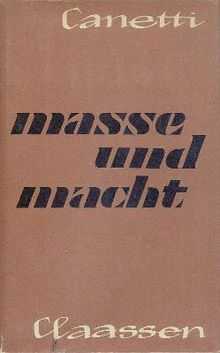Crowds and Power

Crowds and Power (original German title Masse und Macht) is a 1960 book by Elias Canetti, dealing with the dynamics of crowds and "packs" and the question of how and why crowds obey rulers. Canetti draws a parallel between ruling and paranoia. Also, the memoirs of Daniel Paul Schreber are analyzed with an implicit critique of Sigmund Freud.
The book was translated from German into English by Carol Stewart in 1962 and published by Gollancz.
It is notable for its unusual tone; although wide ranging in its erudition, it is not scholarly or academic in a conventional way. Rather, it reads like a manual written by someone outside the human race explaining to another outsider in concise and highly metaphoric language how people form mobs and manipulate power. Unlike most non-fiction writing, it is highly poetic and seething with anger.
On asking questions: "On the questioner the effect is a feeling of enhanced power. He enjoys this and consequentially asks more and more questions; every answer he receives is an act of submission. Personal freedom consists largely in having a defense against questions. The most blatant tyranny is the one which asks the most blatant questions." [1]
This work remains important for the insights it provided into the Eastern European upheaval which can be understood within the framework Canetti puts forth.[2] Showing the growth of crowds and their power against even the power of the state.
Canetti’s Crowds and Power remains an important work of our century, the insights of which in recent years have once again been corroborated in a particularly spectacular fashion. The Eastern European political and economic transition, which has proved to be especially fruitful from a theoretical point of view, can be meaningfully interpreted and hermeneutically “read” within the framework of Canetti’s mass psychology.
Notes
Bibliography
- Brill, Lesley, "Terrorism, Crowds and Power, and the Dogs of War," Anthropological Quarterly 76(1), Winter 2003: 87-94.
- Canetti, Elias (1984). Crowds and Power (in English). New York: Farrar, Straus and Giroux. p. 495. ISBN 0-374-51820-3.
- Honneth,Axel, "The Perpetuation of the State of Nature: on the Cognitive Content of Elias Canetti's Crowds and Power," Thesis Eleven 1996 45: 69-85.
- Kiss,Endre, "Does mass psychology renaturalize political theory? On the methodological originality of “Crowds and Power”," The European Legacy: Toward New Paradigms 9(6), 2004: 725-738.
- McClelland,John, "The Place of Elias Canetti's Crowds and Power in the History of Western Social and Political Thought," Thesis Eleven 1996 45: 16-27.
- Phillips, William, "History on the Couch", The New York Review of Books, Volume 1, Number 1, February 1, 1963.